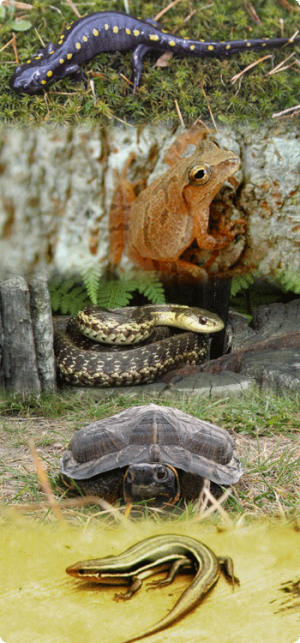Reptiles (snakes, lizards, and turtles) and amphibians (frogs, toads, and salamanders) are valued by many Vermonters.
We look forward to the song of the spring peeper, heralding the arrival of warmer weather, spend rainy nights in springtime helping salamanders and frogs safely cross busy roads, and stop on the roadside to admire a string of painted turtles basking on a log.
Vermont is home to:
- 10 salamander species
- 8 frog species
- 2 toad species
- 11 snake species
- 7 turtle species
- 1 lizard species (Common five-lined skink)
Vermont may have lost one species in recent times, the boreal chorus frog, last heard in 1999.
Of the 40 reptile and amphibian species in Vermont, 19 are considered rare, uncommon, or otherwise at-risk, and their populations are documented in the Vermont Natural Heritage Database. Eight are on Vermont’s list of Threatened and Endangered Species.
Several factors threaten Vermont’s reptile and amphibian populations, including habitat loss, road mortality, illegal collection and killing, pollution, and disease.
Wildlife Diversity Program biologists survey, monitor, and study Vermont’s reptiles and amphibians to better understand their needs and ensure their survival into the future.
Additional Resources
Reptiles and Amphibians of Vermont- A list of reptiles and amphibians regularly found in Vermont as well as their conservation status.
Vermont Herp Atlas –Collects and disseminates information about the natural history, distribution, and effective conservation of Vermont’s reptiles and amphibians. Volunteers, other conservation organizations, and atlas staff members collect data needed to make informed recommendations regarding the state status, state rank, and conservation of Vermont’s reptiles and amphibians.
Vernal Pool Mapping Project – This project has mapped the location of nearly 5,000 potential and know vernal pools across Vermont, helping landowners, municipal officials and citizen naturalists protect these wetlands and their amphibians and invertebrates communities.
See also:
- Snakes of Vermont
- Turtle Nesting FAQs
- Turtle Project Results
- Vermont Critters - Reptiles
- Vermont Critters - Amphibians
- Lists of Animal Species Found in Vermont
- List of Endangered and Threatened Animals of Vermont
- List of Rare and Uncommon Animals in Vermont
- Recovery Plans for Threatened & Endangered Species
- Wildlife Action Plan
- Citizen Reporting Forms for Rare Animals
- Rattlers Peepers & Snappers Video
- NatureServe Explorer
